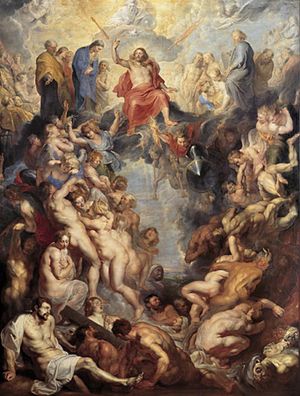The Great Last Judgment

|
| The Great Last Judgment |
|---|
| Peter Paul Rubens , 1617 |
| Oil on canvas |
| 608.5 × 463.5 cm |
| Old Pinakothek |
The Great Last Judgment is an oil painting from the workshop of Peter Paul Rubens , which was completed in 1617 . It is the largest picture Rubens ever painted. The height is 6,085 and the width is 4,635 meters. The canvas panels are sewn together several times. It is the first of several thematically similar works by Rubens; In 1619 the so-called "Little Last Judgment" followed and in 1620 " The Fall of the Damned ".
description
The Last Judgment , divorce after death in the Christian imagination, is conveyed in a lively and dramatic way. At the top of the picture is the judging Jesus, to his right is Mary . To his left, to the right of the viewer, is Moses with the tablets of the law in his hand. On the left half of the picture are the believers who are allowed to go to heaven , on the right side the unbelieving or sinful damned. At the bottom are the deceased and dying.
History of the painting
It is believed that ten to twenty artists worked on the picture; however, the only signature on the picture is that of Rubens. The master took care of the design and the final nuances.
The picture, as well as two associated side parts, were commissioned for Wolfgang Wilhelm von Pfalz-Neuburg and were intended to serve as the altarpiece of the high altar in the court church in Neuburg an der Donau , which was given to the Jesuits in 1618 in the course of the Counter-Reformation . The colossality of the image and the image program are to be understood against the background of the approaching Thirty Years War and the Counter Reformation, which was pushed ahead with great severity in the Principality of Pfalz-Neuburg . The motif of the Last Judgment was next to that of the fall of the angel by the Archangel Michael the most popular symbol of counter-Reformation propaganda. The painting, however, caused offense because of the depicted naked bodies and was partially imposed until the founder's grandson, Johann Wilhelm , brought it to the Düsseldorf gallery in 1692 .
After the Palatine Elector Karl Theodor succeeded the Bavarian throne in 1777 and moved his court to Munich, the Mannheim and Zweibrücker galleries and, under his successor Maximilian IV. Joseph, finally also the Düsseldorf gallery were transferred to the Bavarian capital in 1805/06. There, the Great Last Judgment was initially housed in the gallery in the Hofgarten arcades. It is now in the Alte Pinakothek and is the largest picture in the museum (Inv.-No. 890). It is centrally located in room VII on the first floor. This so-called “Rubens Hall”, which with its triumphal gate opposite and referring to the painting, was designed especially for the painting, is again the largest hall in the museum. The painting is the only one that is still in the same place as it was when the museum was founded in 1836.
The two side panels showing the Adoration of the Shepherds and the pouring out of the Holy Spirit are located in the Staatsgalerie Neuburg .
reception
Jacob Burckhardt judges the painting rather disparagingly than
“Michelangelesque and yet free from Michelangelo: the pan-devil who runs away with the two women on the right; Above this time a true and wonderful glory of the blessed of the old and new covenants: Adam and Eve (these old Upper German innocent), Moses, Maria (wonderfully beautiful, deeply bowing), Peter, John the Baptist, etc. Peter and Moses as wingmen; Christ (Jupiter) somewhat theatrical ... "
On the other hand, the enthroned Christ figure, who “turns to the redeemed, inviting them lovingly to paradise, without at the same time repelling the damned” appears to the theologian Mareike Hartmann “very human and tender”. This gives “the image of the court a very positive basic mood” - at least in comparison to the gloomy view of the little Last Judgment that emerged later and the fall of hell.
Web links
- Peter Paul Rubens (1577-1640): The Great Last Judgment. In: bavarikon. Bavarian State Library, accessed on December 13, 2016 .
swell
- ↑ according to more recent studies possibly not until 1628, cf. z. B. Mareike Hartmann: Hell scenarios . An analysis of the understanding of hell in different epochs on the basis of depictions of hell (= aesthetics - theology - liturgy . Volume 32 ). Lit , Münster 2005, ISBN 3-8258-7681-0 , p. 60 ( limited preview in Google Book Search [accessed April 13, 2013]).
- ^ Thomas Aniol: Neuburg Castle. State Gallery - Flemish Baroque Painting. Bavarian Administration of State Palaces, Gardens and Lakes, accessed on April 13, 2013 .
- ↑ a b The Great Last Judgment. In: The Pinakotheken in the Munich Art Area. Bayerische Staatsgemäldesammlungen, accessed on December 28, 2016 .
- ^ Josef Hugo Biller, Hans-Peter Rasp: Munich Art & Culture. City guide and manual . 15th completely revised edition. Ludwig, Munich 2003, ISBN 3-7787-5125-5 , p. 90 .
- ^ Jacob Burckhardt : Modern art since 1550 . In: Eva Mongi-Vollmer and Wilhelm Schlink (eds.): Works. Critical complete edition . tape 18 . CH Beck, Munich 2006, ISBN 978-3-406-53134-7 , p. 406 ( limited preview in Google Book search).
- ↑ Hartmann: Hell scenarios . 2005, p. 59 ( limited preview in Google Book search).
